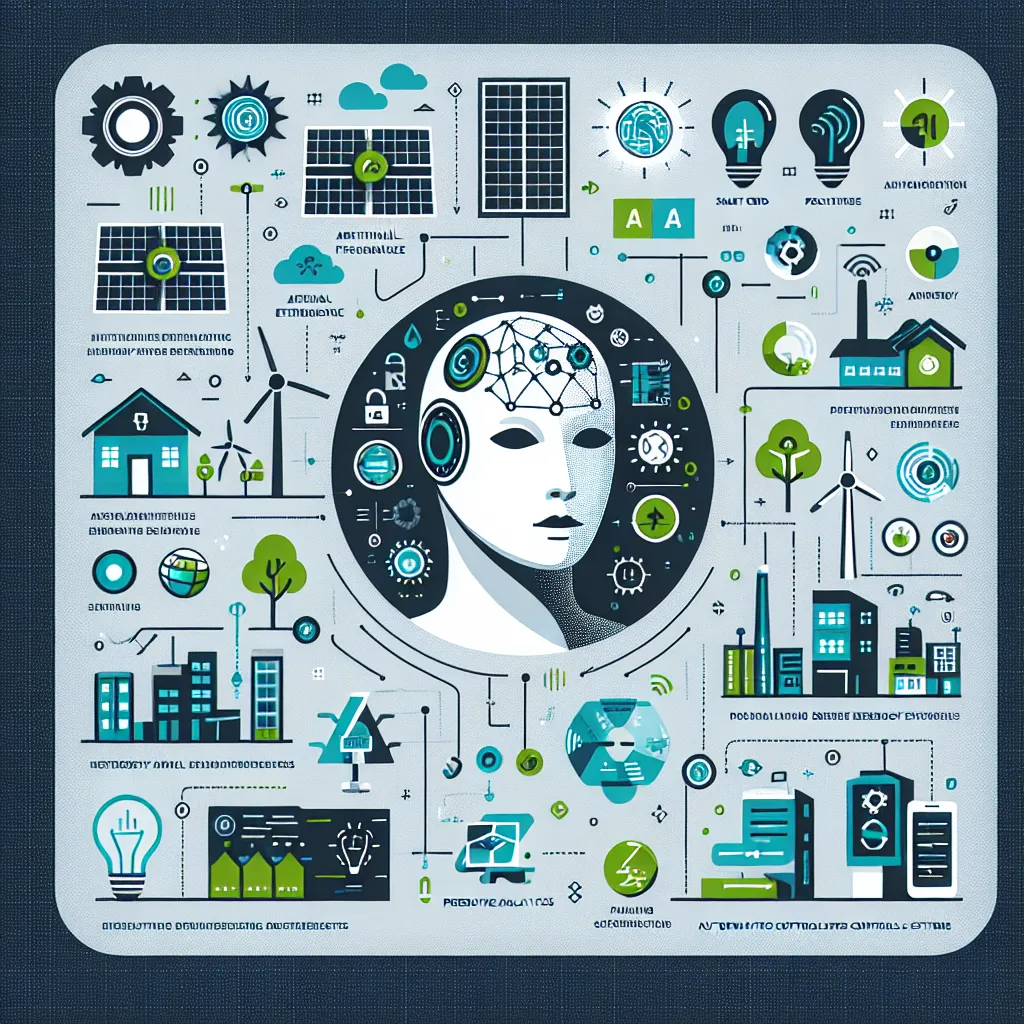The IELTS Reading section is a crucial component of the test, assessing your ability to comprehend complex texts and extract relevant information. Today, we’ll focus on a topic that has been increasingly prevalent in recent years: AI’s role in energy efficiency. This subject combines technological advancements with environmental concerns, making it a prime candidate for IELTS Reading passages.
Based on current trends and the growing importance of sustainable technologies, there’s a high likelihood that similar topics will appear in future IELTS exams. Let’s dive into a practice passage that mirrors the style and difficulty of an actual IELTS Reading test.
 AI and Energy Efficiency Infographic
AI and Energy Efficiency Infographic
Practice Reading Passage
AI’s Revolutionary Impact on Energy Efficiency
A) Artificial Intelligence (AI) is revolutionizing numerous sectors, and its impact on energy efficiency is particularly significant. As the world grapples with climate change and the need for sustainable energy solutions, AI emerges as a powerful tool in optimizing energy consumption and promoting eco-friendly practices.
B) One of the most promising applications of AI in energy efficiency is in smart grid management. Traditional power grids often struggle with balancing supply and demand, leading to energy waste and potential blackouts. AI algorithms can analyze vast amounts of data from various sources, including weather forecasts, historical usage patterns, and real-time consumption metrics, to predict energy demand with unprecedented accuracy. This allows for more efficient energy distribution and reduces the need for excess energy production.
C) In the realm of building energy management, AI is making substantial strides. Smart building systems equipped with AI can automatically adjust heating, cooling, and lighting based on occupancy, time of day, and external conditions. For instance, machine learning algorithms can learn from occupants’ behavior and preferences to create personalized comfort settings while minimizing energy waste. Some advanced systems can even anticipate maintenance needs, preventing energy-draining malfunctions before they occur.
D) The manufacturing sector, traditionally a large consumer of energy, is also benefiting from AI-driven efficiencies. AI-powered systems can optimize production schedules to reduce energy consumption during peak hours, identify and eliminate inefficiencies in manufacturing processes, and even suggest design improvements for more energy-efficient products. This not only reduces the carbon footprint of industries but also leads to significant cost savings.
E) Renewable energy sources, such as solar and wind power, are becoming increasingly viable thanks to AI. The intermittent nature of these energy sources has been a significant challenge, but AI is helping to overcome this hurdle. Predictive algorithms can forecast renewable energy generation based on weather patterns, enabling better integration with traditional power sources. Additionally, AI can optimize the placement and angle of solar panels or the positioning of wind turbines to maximize energy capture.
F) Transportation, another major contributor to energy consumption, is being transformed by AI. From optimizing routes for delivery vehicles to improving traffic flow in cities, AI is reducing fuel consumption and emissions. In the realm of electric vehicles, AI is crucial in developing more efficient batteries and optimizing charging schedules to reduce strain on the power grid.
G) However, the implementation of AI in energy efficiency is not without challenges. The development and training of AI models require significant computational power, which itself consumes energy. There are also concerns about data privacy and security, as AI systems often rely on vast amounts of personal and industrial data. Moreover, there’s a risk of over-reliance on AI, potentially leading to vulnerabilities if these systems fail.
H) Despite these challenges, the potential benefits of AI in enhancing energy efficiency are immense. As AI technologies continue to evolve and become more sophisticated, their role in creating a more sustainable energy future is likely to expand. From smart homes to industrial processes, AI is paving the way for a more energy-efficient world, contributing significantly to global efforts to combat climate change and reduce carbon emissions.
Questions
True/False/Not Given
Do the following statements agree with the information given in the reading passage? Write
TRUE if the statement agrees with the information
FALSE if the statement contradicts the information
NOT GIVEN if there is no information on this
- AI can predict energy demand more accurately than traditional methods.
- Smart building systems with AI can learn from occupants’ behavior to create personalized settings.
- AI-powered systems in manufacturing always lead to cost savings.
- AI can optimize the placement of renewable energy sources to maximize energy production.
- The use of AI in energy efficiency has no associated challenges or drawbacks.
Multiple Choice
Choose the correct letter, A, B, C, or D.
-
According to the passage, how does AI help in smart grid management?
A) By increasing energy production
B) By predicting energy demand accurately
C) By eliminating the need for human operators
D) By completely replacing traditional power grids -
Which of the following is NOT mentioned as a benefit of AI in building energy management?
A) Adjusting heating based on occupancy
B) Creating personalized comfort settings
C) Anticipating maintenance needs
D) Designing the building’s architecture -
How does AI contribute to the viability of renewable energy sources?
A) By eliminating the need for traditional power sources
B) By creating new types of renewable energy
C) By forecasting renewable energy generation
D) By directly increasing the energy output of solar panels
Matching Headings
Match the following headings to the correct paragraphs in the passage. Write the correct letter, A-H, next to numbers 9-13.
- Paragraph C
- Paragraph D
- Paragraph E
- Paragraph F
- Paragraph G
List of Headings:
i. Challenges in implementing AI for energy efficiency
ii. AI’s role in optimizing renewable energy sources
iii. The future of AI in energy sustainability
iv. Smart buildings and personalized energy management
v. AI-driven efficiencies in manufacturing
vi. AI’s impact on transportation and energy consumption
Summary Completion
Complete the summary below using words from the box.
predicting, renewable, smart grids, manufacturing, transportation, challenges
AI is playing a crucial role in improving energy efficiency across various sectors. In power distribution, AI helps manage (14)__ by accurately (15)__ energy demand. The (16)__ sector benefits from AI through optimized production schedules and process improvements. AI also enhances the viability of (17)__ energy sources by forecasting generation and optimizing placement. In the (18)__ sector, AI contributes to reducing fuel consumption and emissions. However, there are (19)__ associated with implementing AI in energy efficiency, including high energy consumption for AI development and data privacy concerns.
Answer Key and Explanations
True/False/Not Given
- TRUE – Paragraph B states that AI algorithms can predict energy demand with “unprecedented accuracy.”
- TRUE – Paragraph C mentions that “machine learning algorithms can learn from occupants’ behavior and preferences to create personalized comfort settings.”
- NOT GIVEN – While the passage mentions cost savings, it doesn’t state that AI-powered systems always lead to cost savings in manufacturing.
- TRUE – Paragraph E states that “AI can optimize the placement and angle of solar panels or the positioning of wind turbines to maximize energy capture.”
- FALSE – Paragraph G explicitly discusses challenges and drawbacks associated with AI in energy efficiency.
Multiple Choice
- B – Paragraph B explains that AI can predict energy demand accurately, which helps in smart grid management.
- D – The passage mentions adjusting heating, creating personalized settings, and anticipating maintenance, but not designing architecture.
- C – Paragraph E states that “Predictive algorithms can forecast renewable energy generation based on weather patterns.”
Matching Headings
- iv – Paragraph C discusses smart buildings and personalized energy management.
- v – Paragraph D focuses on AI-driven efficiencies in manufacturing.
- ii – Paragraph E talks about AI’s role in optimizing renewable energy sources.
- vi – Paragraph F discusses AI’s impact on transportation and energy consumption.
- i – Paragraph G outlines challenges in implementing AI for energy efficiency.
Summary Completion
- smart grids
- predicting
- manufacturing
- renewable
- transportation
- challenges
Common Mistakes to Avoid
-
Overlooking specific details: In IELTS Reading, it’s crucial to pay attention to precise wording. For example, in question 3, the word “always” is key to determining that the answer is “NOT GIVEN.”
-
Making assumptions: Avoid drawing conclusions not explicitly stated in the text. For instance, while AI is mentioned as beneficial for renewable energy, it doesn’t state that it eliminates the need for traditional power sources (question 8).
-
Misinterpreting Heading matches: Ensure you understand the main idea of each paragraph before matching headings. The heading should encapsulate the paragraph’s primary focus.
-
Rushing through Summary Completion: Take time to understand the context of each gap and consider how the missing word fits grammatically and semantically into the sentence.
Key Vocabulary
-
Artificial Intelligence (AI): /ˌɑːtɪˈfɪʃəl ɪnˈtelɪdʒəns/ (noun) – The simulation of human intelligence processes by machines, especially computer systems.
-
Energy Efficiency: /ˈenədʒi ɪˈfɪʃənsi/ (noun) – The goal to reduce the amount of energy required to provide products and services.
-
Smart Grid: /smɑːt ɡrɪd/ (noun) – An electricity supply network that uses digital communications technology to detect and react to local changes in usage.
-
Machine Learning: /məˈʃiːn ˈlɜːnɪŋ/ (noun) – A subset of AI that provides systems the ability to automatically learn and improve from experience without being explicitly programmed.
-
Renewable Energy: /rɪˈnjuːəbəl ˈenədʒi/ (noun) – Energy from a source that is not depleted when used, such as wind or solar power.
-
Carbon Footprint: /ˈkɑːbən ˈfʊtprɪnt/ (noun) – The amount of carbon dioxide and other carbon compounds emitted due to the consumption of fossil fuels by a particular person, group, or organization.
Grammar Focus
Pay attention to the use of present perfect tense in the passage, which is used to describe recent developments with current relevance:
“AI is making substantial strides.” (Paragraph C)
“AI technologies continue to evolve and become more sophisticated.” (Paragraph H)
This tense is commonly used in academic and scientific writing to discuss ongoing research and developments.
Tips for IELTS Reading Success
-
Practice active reading: Engage with the text by underlining key points and making mental notes as you read.
-
Improve your vocabulary: Regularly learn new words related to technology, environment, and energy, as these topics are common in IELTS.
-
Time management: Allocate your time wisely. Spend about 20 minutes on each passage in the IELTS Reading test.
-
Skim and scan effectively: Quickly identify main ideas (skimming) and locate specific information (scanning) to answer questions efficiently.
-
Pay attention to transition words: Words like “however,” “moreover,” and “despite” often signal important points or contrasts in the text.
-
Practice with various question types: Familiarize yourself with all IELTS Reading question formats to improve your speed and accuracy.
-
Read widely: Expose yourself to a variety of academic texts to improve your reading speed and comprehension.
Remember, consistent practice is key to improving your IELTS Reading score. Regularly engaging with complex texts on diverse topics will enhance your ability to handle the challenges of the IELTS Reading test.
For more practice on IELTS Reading, you might find our articles on AI’s role in developing smart infrastructure and how AI is being used to enhance energy efficiency helpful. These resources provide additional context and practice opportunities related to AI and energy topics.


